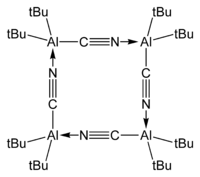- Diethylaluminium cyanide
-
Diethylaluminium cyanide  diethylalumanylformonitrileOther namesCyanodiethyl Aluminum
diethylalumanylformonitrileOther namesCyanodiethyl Aluminum
(cyano-κC)diethyl-Aluminum
(cyano-C)diethyl-Aluminum
Cyanodiethyl-(7CI,8CI) Aluminum
Cyanodiethylallane
Cyanodiethylaluminum
Diethylaluminum CyanideIdentifiers CAS number 5804-85-3 
Properties Molecular formula C4H10AlCN
Et2AlCNMolar mass 111.12 g/mol Appearance colorless liquid Density 0.864 g/cm3 at (25 °C) liquid Boiling point 162 °C/0.02 mmHg (435.15 K) °F)
Solubility in water Benzene, Toluene, diisopropyl ether  (verify) (what is:
(verify) (what is:  /
/ ?)
?)
Except where noted otherwise, data are given for materials in their standard state (at 25 °C, 100 kPa)Infobox references Diethylaluminum cyanide is the organoaluminum compound with formula ((C2H5)2AlCN)n. This compound is usually handled as a solution in toluene. This compound is a reagent for the hydrocyanation of α,β-unsaturated ketones.[1] [2] [3][4][5]
Contents
Synthesis
Diethylaluminum cyanide was originally produced in 1966. It is generated by the treatment of triethylaluminum with a slight excess of hydrogen cyanide. The product is typically stored in ampoules because it is highly toxic. It dissolves in toluene, benzene, hexane and isopropyl ether. It undergoes hydrolysis readily and is not compatible with protic solvents.
- Et3Al + HCN → Et2AlCN + Et-H
Structure
Diethylaluminum cyanide has not been examined by X-ray crystallography, although other diorganoaluminum cyanides have had their crystal structures determined. Diorganylaluminum cyanides have the general formula (R2AlCN)n, and they exist as cyclic trimers (n = 3) or tetramers (n = 4). In these oligomers one finds AlCN---Al linkages.
A compound similar to diethylaluminum cyanide is bis(trimethylsilyl)methyl]aluminium cyanide, ((Me3Si)2CH)2AlCN, which has been shown crystallographically to exist as a trimer with the following structure:[6]
More recently, bis(hydrocarbyl)aluminium cyanides have been structurally characterized, such as bis(tert-butyl)aluminium cyanide, tBu2AlCN, which forms a tetramer in the crystalline phase:[7][8]
Uses
Diethylaluminum cyanide is used for hydrocyanation of α,β- unsaturated ketones. The reaction is influenced by the basicity of the solvent. This effect arises from the Lewis acidic qualities of the reagent.[9] The purpose of this reaction is to generate alkylnitriles which are precursors to amines, amides, carboxylic acids and esters.
References
- ^ Nagata, W (1966). "Alkylaluminum cyanides as potent reagents for hydrocyanation". Tetrahedron Letters 7 (18): 1913–1918. doi:10.1016/S0040-4039(00)76271-X.
- ^ http://www.sigmaaldrich.com/catalog/ProductDetail.dolang=en&N4=276863%7CALDRICH&N5=SEARCH_CONCAT_PNO%7CBRAND_KEY&F=SPEC
- ^ Uhl, Werner; SchüTz, Uwe; Hiller, Wolfgang; Heckel, Maximilian (1995). "Synthese und Kristallstruktur des trimeren [(Me3Si)2CH]2Al?CN". Zeitschrift für anorganische und allgemeine Chemie 621: 823–828. doi:10.1002/zaac.19956210521.
- ^ Wade, K.; Wyatt, B. K. (1969). "Reactions of organoaluminium compounds with cyanides. Part III. Reactions of trimethylaluminium, triethylaluminium, dimethylaluminium hydride, and diethylaluminium hydride with dimethylcyanamide". Journal of the Chemical Society A: Inorganic, Physical, Theoretical: 1121–1124. doi:10.1039/J19690001121.
- ^ Coates, G. E.; Mukherjee, R. N. (1963). "35. Dimethylaluminium cyanide and its gallium, indium, and thallium analogues; beryllium and methylberyllium cyanide". Journal of the Chemical Society (Resumed): 229–232. doi:10.1039/JR9630000229.
- ^ Uhl, Werner; Schütz, Uwe; Hiller, Wolfgang; Heckel, Maximilian (1995). "Synthese und Kristallstruktur des trimeren [(Me3Si)2CH]2Al—CN". Z. anorg. allg. Chem. 621 (5): 823–828. doi:10.1002/zaac.19956210521.
- ^ Uhl, Werner; Matar, Madhat (2004). "Hydroalumination of Nitriles and Isonitriles". Z. Naturforsch., B: Chem. Sci. 59 (11/12): 1214–1222. http://www.znaturforsch.com/ab/v59b/59b1214.pdf.
- ^ Uhl, Werner; Schütz, Uwe; Hiller, Wolfgang; Heckel, Maximilian (2005). "Synthese und Kristallstruktur des trimeren [(Me3Si)2CH]2Al—CN". Z. Naturforsch., B: Chem. Sci. 60 (2): 155–163. http://www.znaturforsch.com/ab/v60b/60b0155.pdf.
- ^ W. Nagata and M. Yoshioka (1988), "Diethylaluminum cyanide", Org. Synth., http://www.orgsyn.org/orgsyn/orgsyn/prepContent.asp?prep=cv6p0436; Coll. Vol. 6: 436
Categories:- Cyanides
- Organoaluminium compounds
Wikimedia Foundation. 2010.

![trimeric bis(trimethylsilyl)methyl]aluminium cyanide](/pictures/enwiki/51/300px-Cyclo-%28%28%28Me3Si%292CH%292AlCN%293-2D.png)

